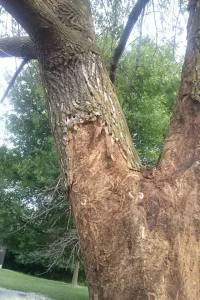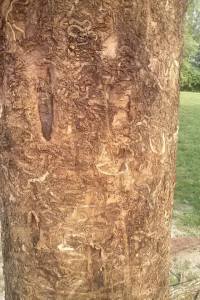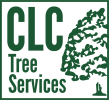Yet more examples of what the deadly emerald ash borer (EAB) can do…
 This ash tree can be found in the playground of a local London-area public school. In their curiousity, the children there discovered that the bark was loose on this tree. Quick as a wink, they had stripped the tree of its lower bark, revealing the devastating signs that the emerald ash borer had been there – twisting veins and paths all over the trunk. Just above, where the bark still remains, you can see the obvious wholes where the borer has left its mark.
This ash tree can be found in the playground of a local London-area public school. In their curiousity, the children there discovered that the bark was loose on this tree. Quick as a wink, they had stripped the tree of its lower bark, revealing the devastating signs that the emerald ash borer had been there – twisting veins and paths all over the trunk. Just above, where the bark still remains, you can see the obvious wholes where the borer has left its mark.
 The real story of course lies just below the surface. This ash tree is riddled with the deadly beetle. While some upper branches retain leaves, many of the brittle limbs remain empty, devoid of foliage. Not much can be done for these cherished shade providers. Two other ash trees stand nearby, resigned to the same fate.
The real story of course lies just below the surface. This ash tree is riddled with the deadly beetle. While some upper branches retain leaves, many of the brittle limbs remain empty, devoid of foliage. Not much can be done for these cherished shade providers. Two other ash trees stand nearby, resigned to the same fate.
EAB – The Same Fate All Over
The story is the same throughout London. In fact, the emerald ash borer has left its mark on ash trees across Ontario, and continues to spread. Since it was discovered in Windsor in 2002, this virulent, invasive species has been confirmed in 30 Ontario counties, as well as 7 in Quebec. And most recently, on June 21st, 2013, the Canadian Food Inspection Agency (CFIA) confirmed that the EAB had been detected in Arnprior, Renfrew County, and in Northumberland County – near Roseneath and Cornwall, and South Mountain in the United Counties of Stormont, Dundas and Glengarry.
Despite restrictions on the movement of any ash materials, the war against the Emerald Ash Borer is still fierce. Threatened trees are being cut down in the millions across North America. CLC Tree Services continues to offer TreeAzin injections to individual business and home owners in London, Ontario. The CFIA continues its surveillance of the borer’s spread. In good news, they have also introduced two varieties of stingless wasps to potentially curb the presence of the EAB. Hopefully this biological control agent will help to make a dent in this pest’s spread.
In the meantime, remember to be vigilant about not transporting ash products, like firewood, wood chips, lumber, logs or other ash wood, from one area to another. And learn to recognize this invasive species in the fight to eradicate it. Because at this rate, our only choice is to continue the fight against it, for us and future generations.





You must be logged in to post a comment.